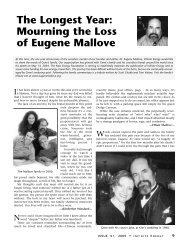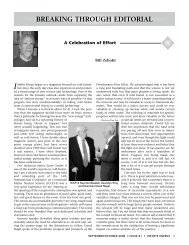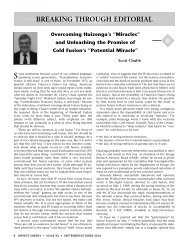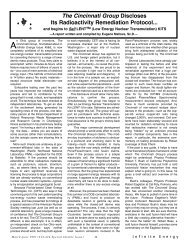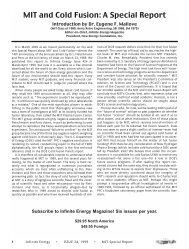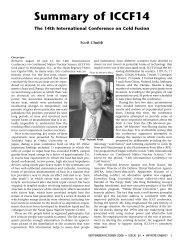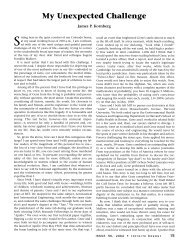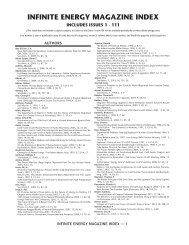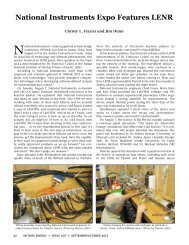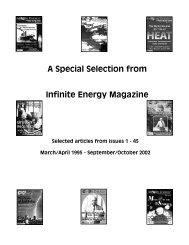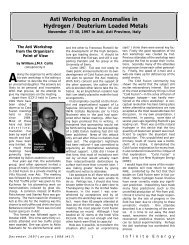Martin Fleischmann's Historic Impact - Infinite Energy Magazine
Martin Fleischmann's Historic Impact - Infinite Energy Magazine
Martin Fleischmann's Historic Impact - Infinite Energy Magazine
Create successful ePaper yourself
Turn your PDF publications into a flip-book with our unique Google optimized e-Paper software.
pected in the generally accepted vision of science, many scientists<br />
didn’t see the point of the importance of the concentration<br />
of deuterons; their attempts to replicate the experiment,<br />
using the well known electrochemical procedures,<br />
failed because they failed to reach the critical threshold.<br />
However, a search for the many-body attraction was going<br />
on, at the same time, in the frame of quantum field theory<br />
(QFT) and quantum electrodynamics (QED). A fundamental<br />
theorem has been proved: “An ensemble of a large number<br />
N of charged particles oscillating between two quantum<br />
states, becomes dynamically unstable when the temperature<br />
T is below a threshold and the density N/V exceeds a critical<br />
value. Under such conditions the minimum energy state of<br />
the system is a state where particles have the same phase (in<br />
a physical jargon are coherent) in tune with a non vanishing<br />
e.m. field trapped within the ensemble itself.” [G. Preparata,<br />
ed. 1995. QED in Condensed Matter, World Scientific] The<br />
negative difference of energy between the initial non-coherent<br />
state and the final coherent state, labelled “energy gap,”<br />
attracts more and more particles to join the coherent state<br />
thus realizing the long range attraction, which adds up to<br />
the short range electrostatic repulsion, just as envisaged by<br />
<strong>Martin</strong>. This theoretical vision, which corroborates <strong>Martin</strong><br />
intuitions, was the reason for his collaboration with<br />
Giuliano Preparata and his colleagues, including us. The first<br />
product of such a collaboration appeared in the Il Nuovo<br />
Cimento issue noted above, where the possible interpretations<br />
of the astonishing experimental data have been discussed.<br />
A further step has been the search for a more efficient<br />
technique to load deuterium inside the palladium lattice.<br />
The solution proposed by Preparata and his group takes<br />
advantage of the property of a quantum system having a<br />
defined quantum phase (then a coherent system) to add up<br />
(algebraically) an external EM potential to its own chemical<br />
potential. This allows, with a suitable choice, the decrease of<br />
the chemical potential of the deuterons inside the palladium,<br />
thus forcing a further uptake of deuterons from outside.<br />
The main results of this research work, realized mainly at<br />
ENEA labs in Frascati (Italy), are not well known in the scientific<br />
community, since the most important journals have<br />
refused to “give a look inside Galileo’s telescope” and to<br />
accept the logical implications of QFT.<br />
The idea of many-body long range attraction among<br />
charged particles does not belong only to the LENR field; it<br />
is, in fact, a general feature of Nature. A close cooperation<br />
with <strong>Martin</strong> went on for many years after the cold fusion<br />
parenthesis, before and after Giuliano Preparata’s untimely<br />
death in 2000, widening in many areas of science.<br />
One important result has been the explanation of the<br />
dynamics of Arrhenius dissociation of electrolytes. It has<br />
been shown that ions suspended in water always enter in a<br />
coherent state, thus making available an energy gap of ~3 eV<br />
per univalent ion. A neutral molecule such as NaCl, having<br />
a binding energy between Na + and Cl - equal to 5.5 eV, finds<br />
its minimum energy level spontaneously splitting in two<br />
separate ions which add up to their respective ionic plasmas.<br />
The same dynamics, proposed to explain LENR, are also able<br />
to explain a household phenomenon such as electrolyte dissociation.<br />
In the same conceptual framework, we discussed with<br />
<strong>Martin</strong> the appearance of the electrolyte deposition on metal<br />
electrodes. But in the last years biology has become more<br />
13 INFINITE ENERGY • ISSUE 105 • SEPTEMBER/OCTOBER 2012<br />
and more an important field of interest in our collaboration<br />
with him and some preliminary reports have been published<br />
[E. Del Giudice, G. Preparata, M. Fleischmann and G. Talpo,<br />
2002. “On the ‘Unreasonable’ Effects of ELF Magnetic Field<br />
upon a System of Ions,” Bioelectr., 23, 522-530; E. Del<br />
Giudice, A. De Ninno, M. Fleischmann, G. Mengoli, M.<br />
Milani, G. Talpo and G. Vitiello, 2005. “Coherent Quantum<br />
Electrodynamics in Living Matter,” Electromagnetic Biology<br />
and Medicine, 24, 190-210].<br />
Now <strong>Martin</strong> Fleischmann has left us. We can presume that<br />
he is continuing the former collaboration with Giuliano<br />
Preparata in a parallel universe, where the idea of coherence<br />
doesn’t antagonize so much its inhabitants.<br />
Dr. Igor Goryachev<br />
(Professor, Research Institute of Nuclear Instrumentation)<br />
It was with deep regret that our group of Russian<br />
researchers learned about Dr. <strong>Martin</strong> Fleischmann’s death on<br />
August 3. This sad news turned out to become a milestone in<br />
the short though bright trace of <strong>Martin</strong>’s cold fusion discovery,<br />
which meant new perspectives for mankind in searching<br />
for future sources of energy.<br />
For me personally it marked an abrupt turn in my life and<br />
career. After years of being engaged in R&D dedicated to<br />
defense problems, I moved to Salt Lake City, one of many<br />
international scientists who at once associated their further<br />
career with this brand new direction in modern physics. My<br />
further cooperation with the University of Utah, the<br />
National Cold Fusion Institute and then with the FEAT and<br />
ENECO companies in Salt Lake during the 1990s actually<br />
determined my involvement in the newly-formed scientific<br />
community in Russia and abroad.<br />
It is clear from the involvement with Dr. Fleischmann and<br />
other scientists in the international cold fusion community<br />
that we Russian scientists had the luck to have, that this new<br />
physics has found many followers in Russia, which will surely<br />
result in decisive breakthroughs with new energy engineering.<br />
We are greatly thankful and feel strongly obliged to<br />
<strong>Martin</strong> Fleischmann for his outstanding discovery which<br />
should provide a brighter future for all mankind.<br />
We will preserve our memory about Dr. <strong>Martin</strong><br />
Fleischmann as one of the most famous electrochemists of<br />
our times.<br />
Roger Stringham<br />
(First Gate <strong>Energy</strong>)<br />
My first personal encounter with <strong>Martin</strong> was at ICCF4 on<br />
Maui. He wanted to know about bubbles and cavitation. I had<br />
advice from a close associate not to get into a discussion with<br />
<strong>Martin</strong> “because he will cut you to pieces.” So when he sat<br />
down next to me in the conference hall I was very nervous,<br />
and was very carful with our conversation. He left saying<br />
something equivalent to “It is all yours.” We had several other<br />
conversations, including one about our next door neighbors,<br />
The Gorilla Foundation, with three full grown gorillas; he,<br />
with a big smile, was also a bit skeptical about that.<br />
The 1989 announcement changed the direction and the<br />
excitement level of my life.<br />
❑ ❑ ❑ ❑



